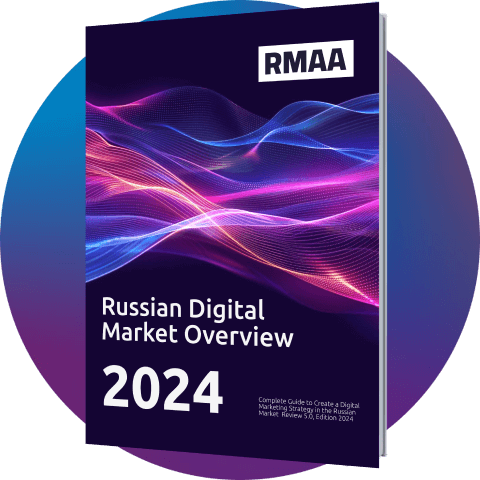Blog about successful marketing strategies in russia
Yandex vs Google in Russia: Search Engine Market Share and Advertising Strategy


DIGITAL MARKETING
Share this Post
As of April 2025, Yandex accounts for 66.59% of all search queries in Russia, while Google holds just 21.44%.

While both platforms still matter, Yandex has become the primary tool for international brands looking to promote in Russia, offering a fully functional advertising dashboard. In contrast, Google’s ad capabilities in the region have been heavily restricted since 2022.
Let’s take a closer look at how the market has shifted and why Yandex is now the key platform for driving effective brand growth in Russia.
Yandex vs Google in Russia: What Changed in 2025?
Over the past few years, the Russian advertising market has undergone major changes, and by 2025, the situation has become clear. While Google remains accessible to regular users, its advertising tools (Google Ads) have been officially non-operational in Russia since 2022.
Meanwhile, Yandex has maintained full functionality and continues to expand its offerings for businesses. As of 2025, the Yandex.Direct ad platform is fully available to international brands and includes a complete set of tools for effective promotion — from search ads and the Yandex Advertising Network to advanced Programmatic formats and in-app advertising.
The key takeaway: In Russia, Google now serves more as a supplementary channel, while meaningful, effective brand promotion is only possible through Yandex.
Why Yandex Is the Smarter Choice for Businesses
Let’s break down four key reasons why Yandex is the network worth investing in.
Full Access to All Ad Formats in One Platform
The Yandex ad platform allows you to reach users at every stage of their journey with your brand, from initial interest to the final decision.
Search ads offer the most direct path to a motivated audience. Your ads appear in direct response to a user’s query, placing your brand right at the center of their attention, at exactly the right time and place.

The Yandex Advertising Network (YAN) offers significantly broader reach. Every day, it connects brands with 85 million users through banners and videos on news sites, niche portals, and mobile apps.
This is where the 'catch the eye' strategy comes into play — reaching people right where they’re reading, watching, or playing.

Here’s what display advertising looks like on a typical website in the Yandex Advertising Network (YAN) — the banner on the right is one of the available formats.

When Is the Right Time to Use Each Format?
If a brand is launching a new product — for example, a cosmetics line or a delivery service — YAN display ads are ideal for making a broad announcement. The user might not be actively searching yet, but they’re already seeing the product: in articles, apps, and on news platforms. This builds brand awareness and sparks initial interest.
But when seasonal demand spikes — like holiday sales, Black Friday, or vacation planning — search advertising becomes indispensable. Users are actively searching with high-intent queries like 'New Year gifts', 'cheap flights', or 'electric scooter deals'. This is where visibility matters most — you want to be the first name they click on.
That’s why both formats often work hand in hand in a smart strategy. YAN warms up interest and drives reach, while search captures those already ready to buy.
Another key direction and a strong reason to use Yandex. Direct is programmatic advertising. By 2025, it already accounts for 84.8% of Russia’s digital ad market. Ads are purchased automatically, with real-time algorithms selecting the right audience based on precise parameters. It’s more accurate, faster, and often more cost-effective than traditional media buying.
A significant share of programmatic impressions in Russia is purchased through the Yandex Advertising Network. Everything placed within it — banners, text ads, in-app formats, video — is treated as programmatic inventory. This isn’t traditional manual advertising; it’s an automated, auction-based system built into the core logic of Yandex.Direct.
When an advertiser launches a campaign within this network, they can choose a manual strategy or let the system handle bidding automatically.
That’s programmatic in action. In the latter case, Yandex’s algorithms analyze user behavior, interests, location, device type, search history, and more. Based on this data, ads are shown to users most likely to take the desired action — whether that’s a click, a visit, a form submission, or a purchase.
This approach is the default within the Yandex Advertising Network.
Another fast-growing channel is in-app advertising. Games, services, utility apps — users spend hours in them. No surprise that in-app formats now account for 25.7% of the entire digital ad market.

Brands use it to stay top of mind during moments of deep engagement — when the user is relaxed, focused, and more open to interaction.
Regional Targeting: Precision at Scale
In a country as geographically diverse as Russia, regional targeting is a critical tool for effective promotion. Yandex.Direct allows advertisers to go beyond broad location settings like region or city, enabling highly detailed targeting down to specific districts and individual towns. This is especially valuable for local businesses or brands running different product campaigns across various regions of the country.
What’s more, Yandex leverages its own geolocation and behavioral analysis algorithms, allowing advertisers to target based on regional preferences and local user behavior with much greater precision.

For example, Bitrix24 promotes its spring event series across Russian cities using regional targeting in Yandex.Direct. The screenshot below shows a banner from the Yandex Advertising Network, served to a user located in Kaliningrad.

Targeting Accuracy — Behavioral and Commercial Metrics
Yandex is increasingly focusing on user behavior and commercial intent. The search engine doesn’t just register a query, it closely monitors what a user does on the website: how long they stay, how many pages they view, and whether they return later. These actions help determine how genuinely interested the user is. That’s when retargeting kicks in — ads are shown to those who’ve already expressed interest but haven’t completed a purchase.
Yandex also evaluates the website itself. Are prices visible and up to date? Is it easy to place an order? Is it clear where to call or how to find the right product? All of this affects how the site ranks in search results. The higher the site's ‘commercial quality’, the better its visibility and the more effective the advertising becomes.
Advanced Campaign Settings — Precision and Flexibility
Yandex.Direct offers highly flexible options for campaign setup. Brands can:
- Choose their payment model — either pay-per-click or pay-per-conversion — and manage bids down to the exact ruble.
- Opt for manual bidding or rely on automated strategies that optimize spend based on your KPIs, such as minimizing cost per conversion or maximizing clicks within a set budget.
- It’s important to note that manual bidding is only available for campaigns targeting Search exclusively. It is no longer supported for YAN-only campaigns or campaigns that combine Search and YAN placements. Learn more.
- Use retargeting by segmenting the audience based on past behavior, for example, showing ads to users who visited the site but didn’t complete a purchase.
- Monitor campaign performance in real time with built-in Yandex.Metrica tools, including conversion reports, click maps, session recordings (Webvisor), and ROI tracking.
Every campaign in Yandex.Direct functions as a full-fledged system, from audience targeting to measurable outcomes.

Today, Yandex.Direct is more than just a platform for running ads. It’s a system that enables brands to manage their budgets intelligently and clearly see what’s working and what isn’t. At every stage, from the first interaction to the final purchase, user behavior is visible. That means brands no longer have to guess, they can act based on real data.
In the context of 2025, Yandex.Direct has become one of the most reliable tools for marketing in Russia. It’s fully accessible to businesses, offers transparent analytics, and shows exactly how every ruble spent is performing.
What’s more, there are already numerous real-world cases where international brands have entered Yandex and achieved measurable results, whether it’s increased conversions or lower lead costs.
For example, Thai luxury developer Banyan Residences Villas Hua Hin reached a Russian audience through a campaign built by RMAA. The promotion ran via Yandex.Direct using search, YAN, and retargeting. Thanks to fine-tuning and a localized strategy, the campaign generated over 240 qualified leads, with a cost per lead that came in below the initial estimate. You can read the full case study here.
Key Features of Paid Ads in Yandex
Paid ads in Yandex offer more than just reach. They provide precise targeting that connects brands with the right audience. This is made possible by a highly flexible targeting system.
If a user has already shown interest in similar products — searching, comparing, or visiting relevant sites — the ads will automatically follow up. Behavioral targeting works like it’s reading intent, bringing users back to where they’re most likely to make a purchase.
When it’s important to appear in the right context, thematic targeting comes into play. Ads are shown on websites and in apps related to the topic at hand. For example, sports nutrition ads appear on fitness platforms, and English course promotions show up on educational sites. This makes the message feel natural and more trustworthy.
And if someone has visited the site but didn’t convert, retargeting helps bring them back. The user sees a familiar ad, returns, and often completes the desired action. This reduces lost leads and improves ad ROI.

The Second key feature is ad pricing. In Yandex, it is determined by an auction system, but it’s not all about the bid. It’s not just how much an advertiser is willing to pay, but also how relevant and useful the ad itself is. Yandex evaluates the overall quality of the ad: how well it matches the user’s query, how often it gets clicked, how smoothly the landing page loads, whether there’s a mobile version, and whether the key information is easy to find.
If the ad is well-crafted, it can secure top positions even with a modest bid. This means you don’t have to outspend competitors to get results. What matters most is being relevant, to the point, and leading users to a seamless buying experience.
How to Improve Your Ads — and Pay Less
To get real results from Yandex.Direct, it’s not enough to set up accurate targeting. Every element that affects how the ad is perceived and rated by the platform needs attention.
Start with the copy. It should be clear and directly aligned with the user’s query. Avoid vague phrases, focus on specifics: what’s being offered, who it’s for, and what the key benefit is. Your wording should be concise, engaging, and easy to grasp.
The more direct and relevant the message, the more likely users are to click. This is especially true for static banners, where the main hook has to come through in the text.
Take, for example, the ad for the residential complex Novaya Deryabikha. A bold offer, a clear condition, and instant readability — the banner isn’t overloaded, but it does the job.

In the beauty segment, a vibrant product shot alone can be effective, especially when the ad format is a short video rather than a static banner. The key is to create visuals that spark emotion, trigger associations, and make users pause, even if just for a second.

An example from the runail_pro campaign — natural lighting, lemons, flowers, and bottles with recognizable packaging. The ad doesn’t feel like an ad, but it grabs attention.
Next comes the landing page. After clicking, the user should immediately see what they were looking for. The page needs to load quickly, display correctly on mobile devices, and include all the essentials: price, product details, and clear options for placing an order or getting in touch.
It’s also important to keep an eye on behavioral metrics. If users are actively clicking and staying on the site, Yandex sees this as a quality signal. As a result, the cost per click goes down, and the campaign becomes more efficient.
What About Google: Should You Ignore It or Not?
Although Google has restricted its advertising capabilities in Russia, it shouldn’t be completely excluded from your media plan in 2025 — and here’s why. The platform still accounts for around 23% of mobile traffic, which translates to roughly 50 million mobile connections. That’s a substantial share that can’t be overlooked when planning campaigns. This is especially relevant considering that Google remains the default search engine on most Android devices. Russians continue to use it to look up products, verify information, and make decisions, even with limited ad functionality.
Source: gs.statcounter.com
Yes, full-scale promotion through Google Ads is currently limited, but maintaining a basic presence is still worthwhile to avoid losing part of the mobile audience, especially from Android devices.
The first step is technical optimization of your website. It should load quickly, be mobile-friendly, and meet Google’s core standards. This helps preserve visibility in search results and ensures continued organic traffic.
The second step is setting up retargeting via the Google Display Network. Despite ongoing restrictions, businesses can still re-engage users who have previously visited their site. This approach allows you to stay in touch with your audience without relying on large-scale campaigns.
A smart strategy isn’t about spreading the budget thin. It’s about maintaining a baseline presence on Google while focusing your main resources on Yandex, which offers consistent reach, detailed analytics, and real tools for managing ad performance.
How SEO Factors Are Evolving in Yandex
Over the past two years, Yandex has significantly changed the rules of the SEO game. Algorithms no longer focus solely on keywords — they’ve become much smarter. What matters now is meaning, structure, and value. The system reads content almost like a human: it evaluates whether the question is answered, if the content is clearly written, and whether the author can be trusted.
SEO in 2025 is no longer about pleasing a machine — it’s a test of authenticity. How helpful is the site, how easy is it to navigate, and does it actually solve the user's problem? Superficial content, filler articles, and unedited AI-generated text no longer work. Why?
Since 2020, Yandex has integrated neural networks like YATI, CS YATI, and YALM, which don’t just recognize phrases — they analyze the depth of thought and clarity of logic. If the content lacks natural language, expertise, and structure, rankings drop. The only reliable way to improve performance is to write content that’s genuinely useful and easy to understand.
But meaning isn’t enough. Formatting matters too. Readability is now key. Subheadings, short paragraphs, bullet points, structured sections, and schema markup help both users and algorithms navigate the page. Rewrites, compilations, and generic SEO copy no longer pass. The algorithms can tell whether a text was written by an expert or a placeholder.
That said, using AI to create content isn’t banned in itself. What matters is whether the content offers real value. Pages created solely to manipulate search rankings, without informing or helping users, risk being downgraded. The same principle applies in Google’s search engine, where the E-E-A-T framework (Experience, Expertise, Authoritativeness, Trustworthiness) is enforced. For example, in March 2024, Google issued manual penalties to 1,446 websites where large portions of content were AI-generated and failed to meet quality standards.
On top of content quality and structure, technical factors remain critical. Yandex looks at page load speed, especially on mobile. A slow or poorly rendered mobile version leads to lower rankings. HTTPS is a must, as is mobile optimization. Without these, a site won’t appear in competitive search results.
User behavior also impacts rankings. If someone clicks a result and immediately returns to search, it sends a negative signal. But if they stay, scroll, and click through to other pages, that indicates the content delivers. These signals are tracked automatically through systems like Proxima and Profit, which assess not just individual pages but the overall usefulness of a search result.
Regional relevance is another important ranking factor. Sites without local targeting often get lost. Yandex prioritizes local interests, so to appear in regional results, it’s important to set your geography in Yandex.Webmaster, create a listing in Yandex.Business, and include photos, reviews, hours of operation, and local keywords—like city names, districts, or metro stations—in your content. These cues help Yandex understand that your business is truly local.
Commercial sites go through an additional layer of assessment. The site must clearly show that users can browse and purchase products. That means visible prices, up-to-date stock info, and no hiding key details behind a “contact manager” button. Delivery terms, payment options, return policies, company background, guarantees, and authentic reviews are now non-negotiable. Without these, a site won’t appear in the commercial search block.
Backlinks still matter, but not the old-school way. You don’t need many, but they must be relevant, from trusted, topic-related sources. Mass link buying, SEO link farms, and fake crowd marketing tactics are easily detected. Yandex tracks which links are organic and which ones are staged.
In short, manipulation no longer works. Yandex now sees the difference between genuine content and a simulation of meaning. Over-optimized pages, fake comments, inflated reviews, and artificial behavioral signals all get filtered out.
In the end, it all comes down to something simple: if a user stays, reads, explores, and engages, your site moves up. If they bounce, it moves down. In 2025, SEO is no longer a bag of tricks. It’s about solid structure, honest content, and real value for people.
References:
- Yandex.Webmaster: Updating Search Algorithms and High-Quality Content on Websites
- Google Search Blog: Google Search and AI Content (Feb 2023)
- Originality.ai: Can Google Detect and Penalize AI Content?
Digital Trends to Consider in Russia in 2025
Paid ads remain the foundation of digital marketing in Russia, but in 2025, their effectiveness depends heavily on how well a brand understands its audience’s digital habits. User behavior has shifted: people are moving away from standard platforms, increasingly opting for private browsing modes and more flexible communication formats. Given this, Telegram has emerged as a major force, no longer just a messenger, but a full-fledged media ecosystem.
In Russia, over 86 million people use Telegram every month. Within the platform, you'll find channels, mini-apps, bots, and ad placements. And advertising here doesn’t feel intrusive. It blends seamlessly into the content flow: within feeds, UI elements, and between blocks of content.
Two-thirds of users engage with ads, largely because they don’t feel disruptive. Instead of banner noise, they appear as a natural part of the interface. Telegram Ads enables both text and media formats in content feeds, while TMA Ads allow brands to place clickable banners and videos inside mini-apps. Targeting is available by interests, location, device type, and in some regions, even by phone number databases.
Learn more about advertising on Telegram and how to combine it effectively with Yandex.Direct in our dedicated article.
As platform restrictions increase and VPN usage grows, traditional targeting methods are becoming less reliable. As of 2025, nearly 42% of Russians access the internet through VPNs, one-third block tracking, and 1 in 5 limits cookies. This erodes ad platforms’ access to user data, which makes closed ecosystems like Yandex and Telegram more valuable than ever. In these environments, users stay logged in, allowing for accurate, data-driven targeting without relying on third-party trackers.

Scrolling through short videos has become second nature. They’re light, spontaneous, and feel more genuine. But straightforward advertising no longer works — people instinctively tune it out. They’re not looking for a brand shouting at them from the screen, but for something more relatable: a reaction, a comment, someone else’s experience.
On platforms like TikTok and VK Clips, everything blends together — personal content, ads, and casual videos. What gets noticed isn’t the loudest voice, but what feels like part of the conversation. That’s why first-person formats work: reviews, unboxings, quick tips. They bring specifics, motion, and tone. They feel human, and that builds trust.
But this calls for a different toolkit: influencer seeding, collaborations, native formats, and partnerships with content creators. Anything that doesn’t feel like marketing, but like part of the natural flow.
In a nutshell
If you're entering the Russian market or refreshing your strategy, it’s important to focus on what actually delivers results.
Start with Yandex. Google Ads is essentially out of play in Russia, while Yandex remains fully operational — search, YAN, programmatic, in-app advertising. The setup is straightforward, support is available, and the results are measurable.
Look beyond Moscow. Regional markets have lower competition and cheaper clicks. Yandex lets you target down to specific cities or towns. The key is to adapt your offers and delivery terms to local audiences.
SEO for Google is still relevant, but only at a basic level. It’s especially important to maintain a mobile-friendly version and keep your brand name visible in search results. This supports user trust and brand loyalty.
Programmatic and in-app advertising have become the norm. Nearly all digital traffic now flows through these channels. They’re highly effective for boosting awareness and reach, especially among mobile-first audiences.
Marketing in Russia today is built on precision targeting, behavioral signals, regional customization, video content, UGC, and increasingly, integration with Telegram, where user attention is deeply focused.
If you’re ready to dive deeper, we’re here to talk. You’ll find a contact form at the bottom of the page. Leave your details, and we’ll help you find the right starting point.
Join 2,000+
of your Peers!
You will be the first to know about Russian marketing insights, news and updates from our agency. Stay tuned!
Get our latest articles delivered to your email inbox and get our exclusive White Paper
"Digital Marketing in Russia. Finding your customers on the internet"
for FREE!
Russian Digital Market Overview
Strategic Insights into Russian Digital Marketing Landscape

Ready to partner with the specialists in Russian marketing and advertising?
About the Author
Digital Strategist. Head of one of the project groups at RMAA. Maria started her journey in digital marketing in 2009.
Join 2,000+ of your Peers!
Get our latest articles delivered to your email inbox and get our exclusive White Paper "Digital Marketing in Russia. Finding your customers on the internet" for FREE!
You will be the first to know about Russian marketing insights,
news and updates from our agency.
Stay tuned!
We're updating our website's design step by step, so some pages may look different. Thank you for your understanding.
Got it














